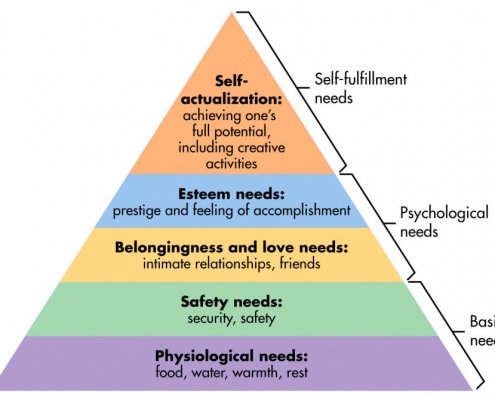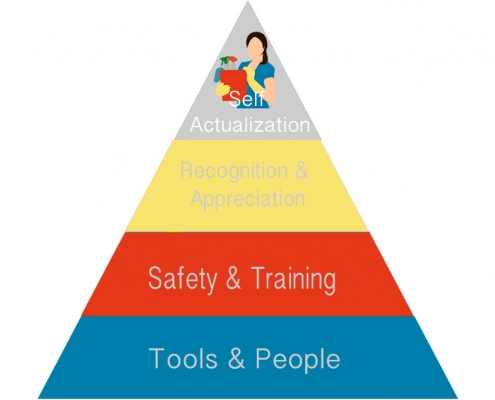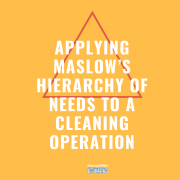Applying Maslow’s Hierarchy of Needs to a Cleaning Operation
In his paper, “A Theory of Human Motivation” published in the 1943 issue of Psychological Review, Abraham Maslow revealed a pyramid in which various levels of human needs were defined (see Figure 1). Ultimately, the theory suggests that humans must cover their most basic needs (like food, shelter and safety) before they can think about higher level goals, like education or relationships.

Maslow’s Hierarchy or Needs (Figure 1).
We can benefit from looking at a cleaning operation in a similar way. There are certain fundamental needs within a custodial operation that must be met in order for the program to be effective and meet certain higher-level goals. Too often, our conversation about cleaning is just through a specific lens rather than looking at the operation as a whole.
When was the last time someone asked you one of the following questions:
- What are you doing to make your team more productive?
- What are you doing to reduce the turnover in your operation?
- How are you reducing injuries?
- Can you stop the man on the third floor from complaining every time we clean his office?
Stepping back and looking at a custodial operation with Maslow’s framework in mind could be useful in answering these questions, and improving your overall operation. Because, if the baseline needs of your cleaning operation aren’t met, how can you make sure it, and all the intricate, moving pieces involved in it, operate at their fullest potential?
___________________________
The Hierarchy of Needs within a Custodial Operation
FOUNDATION: Tools and People
At the foundation of every custodial operation is the tools and labor to clean. In our industry, we spend the majority of our time talking about the tools rather than the labor, but that’s another blog post for another day. If you don’t have equipment, such as flat mops, buckets, auto scrubbers, vacuums, cloths, chemicals—you get where we’re going—then it’s going to be tough to do much cleaning.
The same goes for people. You might have all the best equipment in the world, but without the people to use the equipment, apply the chemicals and remove the soil, you can’t clean.
LEVEL 1: Safety & Training

A cleaning program’s hierarchy of needs.
Once you have the equipment, people and cleaning supplies in place, the next level of any cleaning operation is making sure they have the right training and safety equipment to protect them from injury. Surprisingly, custodians continue to experience one of the highest injury rates of any occupation. Most injuries result from slips and falls, over-exertion and improperly mixing of chemical.
Teaching custodial workers not just what to clean, but HOW to clean is also critical. Help them understand the correct routes to follow, best techniques for lifting heavy equipment and how to prevent cross contamination.
Equipping custodians with the right personal protective equipment is not only the law, it can also go a long way in making them feel more valued, reducing injuries and insurance costs.
LEVEL 2: Recognition and Appreciation
Once the basic elements of the custodial operation are in place, the next level in a custodial operation’s hierarchy of needs is the sense of value. This is instilled by offering recognition to custodial workers and making them feel appreciated for what they do. A lot of housekeeping and environmental service operations use the month of September to recognize employees through events such as housekeepers week or environmental services week, typically the second full week of September.
It’s important not for just custodial management to acknowledge and show appreciation for people who clean our buildings, but everyone within a building. A simple “thank you” helps a custodial worker feel valued for the important work they do.
LEVEL 3: Self Actualization
At the top of the pyramid is self-actualization, which is understanding one’s importance and achieving one’s full potential. When a custodial operation reaches this point, it is filled with a group of engaged team players who strive to work to the best of their abilities. They have been given the supplies and training to do their job effectively, they feel valued and appreciated for their work and do their best to fulfill their role. Because of their engagement, these employees may be well suited to take on new roles or responsibility within the organization and help mentor others.
Would you agree with this proposed hierarchy of needs? What systems do you have in place to create a group of engaged and committed custodians? We’d love to hear your thoughts — please share them on our Facebook page at https://www.facebook.com/managemen.



